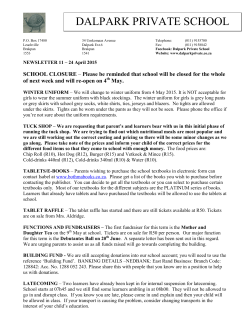
TEACHING KNOWLEDGE TEST
TEACHING KNOWLEDGE TEST LANGUAGES FOR SPECIFIC PURPOSES COURSE ON CULTURAL HERITAGE PRESERVATION GENERAL FRAMEWORK The Teaching Knowledge Test evaluates knowledge of concepts and practice in planning, teaching and assessing a Languages for Specific Purposes course on cultural heritage preservation and valorisation. Prerequisites to the Teaching Knowledge Test are knowledge of concepts related to language and language use; a solid background to and a proven practice of language learning and teaching; as well as competences in lesson planning and use of resources for language teaching, and in managing the teaching and learning process for on-campus and distance audiences. Although language and subject have a joint role in the course, a Content and Language Integrated Learning approach is not fully in place, since chief concern is communication on cultural heritage preservation issues in a foreign language, and not progression in knowledge, skills and understanding in the topic. As a matter of fact, learners are expected to have prior acquaitance with the discipline, in order to proceed smoothly with the exercises. Being more than Content-Based Language Instruction, the course observes a methodology typical for Languages for Specific Purposes lessons. In this context, the course is imparted by proficient language teachers, and not by experts in cultural heritage preservation. Indeed, and although largely evaluating the appropriation of concepts and practice related to Content and Language Integrated Learning, the Teaching Knowledge Test systematically alludes to Languages for Specific Purposes issues, without however assuming subjectspecialised knowledge. This is achieved with carefully selected examples and patterns, which permit teachers to judge their acquaintance with the terminology used in cultural heritage preservation. The Teaching Knowledge Test is based on the relevant Teaching Knowledge Test developed by University of Cambridge ESOL Examinations 1. Qualifications frameworks for language teachers, as well as pertinent examination material – as proposed by Instituto Cervantes 2, Alliance Française 3, Università per Stranieri di Siena 4, Università per Stranieri di Perugia 5, Κέντρο Ελληνικής Γλώσσας 6 – were as well taken into account. Finally, clusters on distance classes greatly benefited from the Guidelines on Virtual Teaching and Learning edited by the relevant Language Centres for Cultural Heritage Preservation 7. The Teaching Knowledge Test consists of 15 exercise clusters, covering knowledge and concepts in language teaching; as well as knowledge of planning, teaching and assessing, and in managing a conventional or virtual classroom. Answering is based on matching, multiple choice or odd one out. Although not exhaustive, numerical lists in the execise clusters are largely acknowledged and may remain unaltered, while alphabetic lists are to be designed anew for each testing session. 1 2 3 4 5 6 7 http://www.cambridgeenglish.org/teaching-english/teaching-qualifications/tkt/ http://cursosinternacionales.usal.es/index.php/es/formacion-de-profesores http://www.alliancefr.org/enseignants-fle http://ditals.unistrasi.it/ https://www.unistrapg.it/didattica/corsi-per-insegnanti-di-italiano-l2 http://www.greeklanguage.gr/node/8 http://www.lsp-heritage.eu/ MODEL TEACHING KNOWLEDGE TEST (I) Match the activities 1-6 with the main aims of teaching Languages for Specific Purposes A-C. Some of the options A-C will be needed more than once. MAIN AIMS OF TEACHING LANGUAGES FOR SPECIFIC PURPOSES A. to focus on specific vocabulary B. to develop communication skills C. to develop language skills related to a well-defined field CLASSROOM ACTIVITIES 1. Learners discuss in groups on the valorisation of an archaeological site. 2. Learners find out different ways for ‘translating’ ancient dyeing recipes in modern scientific language. 3. The teacher highlights the terms on air pollution from a text, which the class has just read. 4. Learners classify ancient ceramics according to their form. 5. Learners describe the outcome of a simulation experiment. 6. Learners present their views on wall-painting restoration using PowerPoint. (II) Mark in each of questions 1-6 the area of language A, B or C that is not essential for performing the relevant task. 1. For A. B. C. writing a paper on unpublished spectroscopic data question forms comparative forms modal verbs expressing possibility / probability 2. For A. B. C. writing a test on the properties of natural colorants exclamations singular and plural forms of nouns the present tense 3. For A. B. C. designing a poster on recent microscopic results in paper investigation conjunctions of time adverbs of frequency question tags 4. For A. B. C. working in groups to label ancient ceramic shreds language for checking answers reported speech sequencing words 5. For taking part in a class discussion conjecturing on the origin of medieval textiles A. vocabulary for expressing feeling B. C. 6. For A. B. C. language for expressing opinions the past tense reconstructing a text on metallurgy in imperial Roman times passive forms superlative forms impersonal pronouns (III) Match the teacher’s questions 1-6 with the main thinking skills A-C they aim to develop. Some of the options A-C will be used more than once. MAIN THINKING SKILLS A. reasoning B. creative thinking C. evaluating TEACHER’S QUESTIONS 1. How would you assess the different mordants in traditional textile dyeing? 2. According to the graph, which is the solvent with the highest extraction efficiency? 3. Who do you think is the most unprejudiced author in this medieval scientific compilation? 4. Which features would you have in your ideal ‘first aid kid’ for conservators? 5. What would you do if you won the first price for restoring a 20th century pictorial work? 6. Which curator behave more responsibly during the discussion on valorising medieval kilns? (IV) Match the instructions 1-6 with the learning skills A-C. Some of the options A-C will be used more than once. LEARNING SKILLS A. locating information B. organising information C. communicating information INSTRUCTIONS 1. Listen to the lecture on restoring ancient town walls, then impart the conclusions to your partner. 2. Find three websites to help you learn more on how European museums address funding problems. 3. Decide which data to exclude as irrelevant from the graph on pollution in open-air museum. 4. Put in the right order the pictures on papermaking. 5. Use any web resources to find information on risk assessment of garment collections. 6. Show your example of an Italian manuscript and explain the watermarks in it. (V) Match the extracts 1-6 from a lesson plan with the lesson plan headings A-G. One of the options A-G will not be used. LESSON PLAN HEADINGS A. syllabus fit B. target language C. intended learning outcomes D. procedure E. thinking skills F. curriculum design G. recources LESSON PLAN EXTRACTS 1. To be able to explain the differences among various paper printing techniques. 2. Outlining the advantages and disantvantages of relief and intaglio printing. 3. A model of a lithographic press. 4. We have studied how the material used for the matrix affects the quality of paper prints, and next lesson will be devoted to polychrome paper prints. 5. A linocut is a relief print on a linoleum matrix; in intaglio printing the image is incised into the matrix; lithography is a mechanical planographic process. 6. Learners immerse cotton fibres in an indigo solution, and then describe the steps of the dyeing procedure. (VI) Match the visual organisers 1-6 with their names A-G. One of the options A-G will not be used. VISUAL ORGANISER NAMES A. cycle B. column table C. Carrol diagram D. pie chart E. Venn diagram F. bar chart G. tree diagram VISUAL ORGANISERS 1. amphora rim neck body 2. NATURAL MANUFACTURED FIBRE COLORANT silk saffron rayon Hansa yellow 3. light grey: madder middle grey: Brazil wood dark grey: cochineal 4. gray: prehistoric ceramic shreds black: Roman ceramic shreds white: mediavel ceramic shreds 5. How often do you: Me Colleague 1 Colleague 2 write reports on your observations as a museum restorer? go to national meetings on cultural heritage valorisation? present your results in conservation science conferences? 6. hue mordant colorant (VII) Match the examples 1-6 from a coursebook with the ways of focusing on content A-G. One of the options A-G will not be used. WAYS OF FOCUSING ON CONTENT A. variety of font styles B. activating prior knowledge C. classification task D. memorising introductory paragraphs E. personalisation F. repetition of key vocabulary G. encouraging production of the target language EXAMPLES 1. What is the role of fixatives in dyeing? 2. Mordants fix the dye to the tissue by forming co-ordination complexes. Mordants are substances, which serve for attaching a dye on a fabric through formation of insoluble compounds. 3. Categorise as organic or inorganic the mordants used in Indian dyeing techniques. 4. Describe briefly all steps of dyeing with purple molluscs. 5. Select all technical terms relevant to colouring lakes from the article in hand. 6. Discuss the problems you encountered when trying to fix madder with alum. (VIII) Match the activities 1-6 with the activity types A-G. One of the options A-G will not be used. ACTIVITY TYPES A. classifying B. matching C. ordering D. odd one out E. labelling F. information transfer G. word completion CLASSROOM ACTIVITIES 1. Read the text and then add the key terms to the drawing of an ancient kiln. 2. Look at the account of ancient smelting procedures, and number the stages as they occur in the process. 3. There are three widely used copper alloys: b…(ronze); b…(rass); g…(unmetal). 4. Organise the techniques used in cultural heritage safeguarding under: separation techniques, identification techniques, restoration techniques. 5. Listen to the recording about ancient mortars and complete the table in your coursebook. 6. Draw a line from the adjectives to the definitions: fragile it bends transparent it can be streched flexible it can be seen through ductile it breaks easily (IX) Match the teacher’s language 1-6 with its teaching purposes A-G. One of the options A-G will not be used. TEACHING PURPOSES A. giving a practical demonstration B. developing learner independence C. activating prior knowledge D. encouraging use of mother tongue E. developing communication skills F. giving feedback G. providing a language support frame TEACHER’S LANGUAGE 1. Let us think together different ways of recording information on paper conservation methods. 2. Discuss with a partner which of the templates will be the most effective for presenting average indoor pollution data. 3. Look at the screen as I explain. Open Excel. Click on the Chart Wizard button and using Column graph, write the indoor pollution data. Click Finish to see the graph. Now you try. 4. Complete these sentences using the information from your graph: The storage room was ________ affected area. The exhibition halls were ________ affected areas. The vestibule was not ________ affected area. 5. Use the internet to find the average indoor pollution data in two archaeological museums, one in the town centre and one in a remote archaeological site. Put the information into a spreadsheet using Excel. 6. You have missed out a column on your spreadsheet. Look at it again and tell me what it is. (X) Match the learner’s language 1-6 with the scaffolding strategies A-C they use during group work. Some of the options A-C will be used more than once. SCAFFOLDING STRATEGIES A. giving positive feedback B. breaking a task down into steps C. reminding the group of the aim of a task LEARNER’S LANGUAGE 1. The first thing we have to do with the spectroscopic data is deciding which criteria we will use to sort them into different columns. 2. The topographic diagram of the site we have drawn should really help us with our homework. 3. We need to work out the fractions without using a calculator. 4. So the idea is to find out which mordant is more appropriate. 5. We must make sure we have saved our results on the spreadsheet before we go on. 6. The chart is accurate, but you need to add a title. (XI) Match the teaching instructions 1-6 with the learning strategies A-G. One of the options A-G will not be used. LEARNING STRATEGIES A. setting learning goals B. using visual prompts to aid memory C. facilitating auditory learning D. identifying key information E. risk-taking F. organising learning G. seeking clarification TEACHING INSTRUCTIONS The teacher tells the students to: 1. 2. 3. 4. Divide their notebooks into separate sections for different conservation science topics. Write the key terms on ancient amphorae in their notebook and illustrate them. Ask for assistance whenever they have not understood how to record air pollution data on graphs. Write a list of the topics they wish to discuss about in the target language by the end of the course. 5. Express their ideas about restoration of pictorial artworks even when they are not sure of the terminology used. 6. Read their advertisements on the National Museum Day aloud to themselves at home. (XII) Match the assessment activities 1-6 with the types of assessment A-G. One of the options A-G will not be used. TYPES OF ASSESSMENT A. teacher assessing learners’ specific language skills B. teacher assessing learner’s general language skills C. teacher assessing the learners’ understanding of content D. learners self-assessing their own specific language skills E. learners is self-assessing their own understanding of content F. learners assessing each other’s specific language skills G. learners assessing each other’s understanding of content ASSESSMENT ACTIVITIES 1. Learners are looking through their notebooks, and are answering questions to find out about what they know and don’t know about ancient mortars. 2. The teacher is marking an exercise on natural colorants, which the learners have written using reported speech. 3. The learners are conducting interviews about diagnostic tests they performed last week, and are making a note of their partner’s use of a scientifically accurate description. 4. Each learner is re-reading a report on ancient dyeing techniques he has written for homework, in order to check whether the terminology is appropriate. 5. Learners have formulated questions about archeaometallurgical issues they studied, and are now talking in groups, asking each other their questions. 6. The teacher is marking an exercise on papermaking techniques, in which the learners have added missing terms. (XIII) Match the language problerms 1-6 a teacher can face when writing a Languages for Specific Purposes test with the possible support strategies A-G. One of the options A-G will not be used. SUPPORT STRATEGIES A. paraphrase parts of the instructions B. use texts that motivate the learners C. let learners partly use their mother tongue D. include a diagram of the text E. allow learners more time F. include a list of useful expressions of a general type G. include a glossary of terms not specific to conservation science LANGUAGE PROBLEMS 1. Learners may not understand the general structure of a report on a monument’s restoration. 2. Learners may not understand several key words in a report about indoor pollution in large cities. 3. Learners may not understand what they need to do while completing missing words in a table on colour hues. 4. Learners may not know the target language sufficiently to write precise definitions of smelting products. 5. Learners often take longer to process both content and target language when reading lengthy texts on the history of art. 6. Learners may not know the target language sufficiently to use expressions necessary for, but not focused on restoration problems. (XIV) Match the teaching instructions 1-6 with the distance learning strategies A-C. Some of the options A-C will be used more than once. DISTANCE LEARNING STRATEGIES A. enhancing distance education transaction B. combining synchronous and asynchronous communication C. using multimedia as an instruction tool TEACHING INSTRUCTIONS The teacher tells the virtual classroom students to: 1. Take the self-assessment test on ancient mortars directly after following the relevant lecture on a videoconference. 2. Look twice at the video and then shortly describe the steps followed in preparing colouring lakes. 3. Work in four-person groups installed in remote locations for completing the exercises on papermaking techniques. 4. Consult the archived glossary before entering the on-line real-time discussion on the restoration of textiles. 5. Acquaint themselves with all steps in the interactive simulation of an ultraviolet-visible spectrometer. 6. Exchange information amid all remote locations before comparing air pollution in various museums. (XV) Match the distance education tools 1-6 with the types of computer-assisted communication A-C. Some of the options A-C will be used more than once. COMPUTER-ASSISTED COMMUNICATION A. asynchronous communication B. interactive synchronous communication C. non-interactive synchronous communication DISTANCE EDUCATION TOOLS 1. On-line tutorial on the use of an optical microscop. 2. Webcast on the valorisation of prehistoric archaeological sites. 3. E-mail to a museum curator. 4. Web conference on ancient ceramics. 5. Wiki on elaboration of pollution statistical data. 6. Access grid on restoration of silk textiles. ANSWER KEY TO THE MODEL TEACHING KNOWLEDGE TEST (I) 1 2 3 4 5 6 B C A A C B (II) 1 2 3 4 5 6 A A C C A B (III) 1 2 3 4 5 6 A A C B B C (IV) 1 2 3 4 5 6 C A B B A C (V) 1 2 3 4 5 6 C E G A B D (VI) 1 2 3 4 5 6 G C D F B E (VII) 1 2 3 4 5 6 B A C G F E (VIII) 1 2 3 4 5 6 E C G A F B (IX) 1 2 3 4 5 6 C E A G B F (X) 1 2 3 4 5 6 B A C C B A (XI) 1 2 3 4 5 6 F B G A E C (XII) 1 2 3 4 5 6 E B F D G A (XIII) 1 2 3 4 5 6 D G A C E F (XIV) 1 2 3 4 5 6 B C A B C A (XV) 1 2 3 4 5 6 A C A B A B
© Copyright 2025









